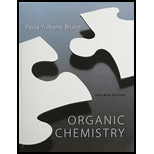
Concept explainers
(a)
Interpretation:
The given alkyl halide forms whether primarily substitution products, only elimination products, both substitution and elimination products, or no products when they react under the given conditions have to be explained.
Concept Introduction:
Elimination Reaction: It is just reverse reaction of addition where substituent from the given molecule is removed via E1 (the reaction depends only on the substrate involved in the reaction) or E2 (the reaction depends on both of the substituents in the reaction) mechanism. Elimination reaction of an alkyl halide results in the formation of an
SN1 Reaction: it is a nucleophilic substitution reaction in which the rate determining step depends on one reactant. First step is the formation of more stable carbocation which is followed by the attack of nucleophile. Formation of more stable carbocation and the leaving group present in the substrate plays very important role in the reactivity of
SN2 reactions take place in primary and secondary
Tertiary alkyl halides undergo both E1 and E2 reactions whereas only E2 reactions take place in primary and secondary alkyl halides.
Carbocation: it is carbon ion that bears a positive charge on it. The increasing stability order of carbocation is as follows,
Primary carbocation < secondary carbocation < tertiary carbocation
Nucleophile: donates pair of electrons to positively charged substrate resulting in the formation of
(b)
Interpretation:
The given alkyl halide forms whether primarily substitution products, only elimination products, either substitution and elimination products, or no products when they react under the given conditions have to be explained.
Concept Introduction:
Elimination Reaction: It is just reverse reaction of addition where substituent from the given molecule is removed via E1 (the reaction depends only on the substrate involved in the reaction) or E2 (the reaction depends on both of the substituents in the reaction) mechanism. Elimination reaction of an alkyl halide results in the formation of an alkene.
SN1 Reaction: it is a nucleophilic substitution reaction in which the rate determining step depends on one reactant. First step is the formation of more stable carbocation which is followed by the attack of nucleophile. Formation of more stable carbocation and the leaving group present in the substrate plays very important role in the reactivity of
SN2 reactions take place in primary and secondary alkyl halides whereas SN1 reactions takes place only in tertiary alky halide.
Tertiary alkyl halides undergo both E1 and E2 reactions whereas only E2 reactions take place in primary and secondary alkyl halides.
Carbocation: it is carbon ion that bears a positive charge on it. The increasing stability order of carbocation is as follows,
Primary carbocation < secondary carbocation < tertiary carbocation
Nucleophile: donates pair of electrons to positively charged substrate resulting in the formation of chemical bond.
Want to see the full answer?
Check out a sample textbook solution
Chapter 10 Solutions
Organic Chemistry & Study Guide and Student Solutions Manual for Organic Chemistry, Books a la Carte Edition (7th Edition)
 ChemistryChemistryISBN:9781305957404Author:Steven S. Zumdahl, Susan A. Zumdahl, Donald J. DeCostePublisher:Cengage Learning
ChemistryChemistryISBN:9781305957404Author:Steven S. Zumdahl, Susan A. Zumdahl, Donald J. DeCostePublisher:Cengage Learning ChemistryChemistryISBN:9781259911156Author:Raymond Chang Dr., Jason Overby ProfessorPublisher:McGraw-Hill Education
ChemistryChemistryISBN:9781259911156Author:Raymond Chang Dr., Jason Overby ProfessorPublisher:McGraw-Hill Education Principles of Instrumental AnalysisChemistryISBN:9781305577213Author:Douglas A. Skoog, F. James Holler, Stanley R. CrouchPublisher:Cengage Learning
Principles of Instrumental AnalysisChemistryISBN:9781305577213Author:Douglas A. Skoog, F. James Holler, Stanley R. CrouchPublisher:Cengage Learning Organic ChemistryChemistryISBN:9780078021558Author:Janice Gorzynski Smith Dr.Publisher:McGraw-Hill Education
Organic ChemistryChemistryISBN:9780078021558Author:Janice Gorzynski Smith Dr.Publisher:McGraw-Hill Education Chemistry: Principles and ReactionsChemistryISBN:9781305079373Author:William L. Masterton, Cecile N. HurleyPublisher:Cengage Learning
Chemistry: Principles and ReactionsChemistryISBN:9781305079373Author:William L. Masterton, Cecile N. HurleyPublisher:Cengage Learning Elementary Principles of Chemical Processes, Bind...ChemistryISBN:9781118431221Author:Richard M. Felder, Ronald W. Rousseau, Lisa G. BullardPublisher:WILEY
Elementary Principles of Chemical Processes, Bind...ChemistryISBN:9781118431221Author:Richard M. Felder, Ronald W. Rousseau, Lisa G. BullardPublisher:WILEY





